Category Archives: CCD Cameras
QuickCam and the Apple II, Part II
Part II – The Software
The software turns out to be a bit easier once all the hardware is built. The two main routines required are the read and write routines. Writing a data byte to the QC involves writing the data to the output port then reading back the echo of the data from the QC to ensure it was received. Reading a data byte from QC involves bringing PCAck (Strobe) high, waiting for the QC to respond with CamRDY high, then reading the first nybble on the input data port. Once the nybble has been read, deassert PCAck (Strobe), wait for CamRDY to go low, then read the second nybble from the input data port. Because of the way the PC parallel port works, Nybble3 from the QC went through an inverter so the QC actually compliments Nybble3 so the PC would read the correct value right from the I/O port. However, the APIC isn’t mapped like the PC parallel port, so this bit will show up inverted on the input data port. The 6502 has to compliment Nybble3 to get the correct value. One other issue mentioned in the hardware post has to be dealt with – the Output Strobe. On the APIC, the Output Strobe connected to PCAck, has an automatic pulse duration that can be set with switches on the card. Because the actual duration of this pulse is dynamic, handshaking with the CamRDY signal, a way to keep re-triggering this signal so it doesn’t prematurely deactivate has to be developed. As luck would have it, the maximum strobe pulse is 15 us, just long enough to check the status of PCAck and either re-trigger the strobe or read the data on the input port before the strobe de-asserts. Finally, reading the echo from a data write is the exact same code as reading a data byte, the two are combined and the data write routine falls right into the data read. Here are the two most important routines with the slot*16 in the X register:
QCWRITE STA $C080,X ; DATA OUT -> CMD
QCREAD STA $C082,X ; STROBE -> PCACK
LSR $C084,X ; ACK (BIT 0) <- CAMRDY
BCC QCREAD
LDA $C083,X ; DATA IN <- HI NYBBLE
AND #$F0 ; DO ENOUGH WORK SO HANDSHAKE CAN BE SKIPPED
EOR #$88 ; COMPLIMENT NYBBLE3
STA TMP
LDA #$0F
AND $C083,X ; DATA IN <- LO NYBBLE
EOR TMP ; COMBINE LO AND HI NYBBLES
RTS
This is the core of the code to read and write the QC. The other important routine is the reset/init routine. The original B/W QC would return a parameter to the GetVersion command of 0. The later Color QC returned a non-zero value, plus an additional value. Care must be taken to take this into account if code is to work on both. Also, this code isn’t smart – if a QC isn’t attached, it will wait forever.
RESET LDA #$FF
STA $C085,X ; RESET QC
JSR $FCA8 ; WAIT
LDA #$17 ; GET_VER
JSR QCWRITE
CMP #$17 ; GOOD ECHO?
BNE QCERR
JSR QCREAD
BEQ QCBW
PHA
JSR QCREAD ; COLOR QC HAS 2 PARMS
PLA
QCBW RTS
Once we can initialize the QC and read and write commands, time to read video frame data. The QC can return pixel data in either 4BPP or 6BPP mode. Due to the limitations of the Apple II graphics, 4BPP seems adequate so I don’t bother with 6BPP. I wrote a very simple program to grab small video frames and put them on the Apple’s low resolution graphics screen. By mapping the color blocks into a corresponding grey scale ramp and displaying the result on a monochrome monitor, live video that roughly resembles what the QC is looking at results. I added controls to adjust the exposure value and contrast to that the best image can be obtained given the severe constraints of 4 bit pixels and a 40×48 graphics mode. Finally, I added a high resolution capture command that would take a video frame and display it on the high res screen. Now the high res screen only shows 1 bit pixels, so I had to employ a primitive error diffusion algorithm to get a respectable image. I’ll let you be the judge of the results:
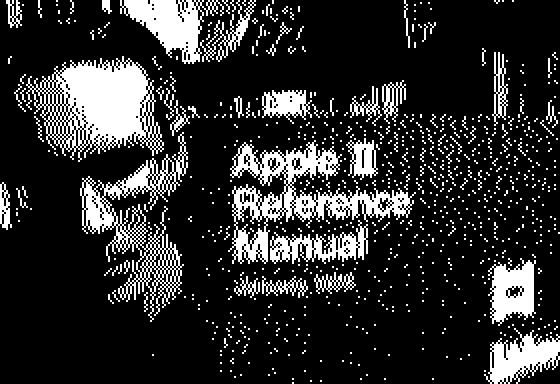
I added a small ordered dither to the pixel calculations to bring out the mid and low grey values. Here is an image of some of my collection:
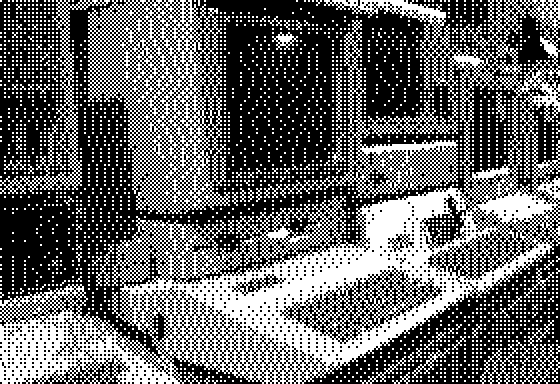
Finally, here is the code for the lo-res video/hi-res frame capture. It isn’t really well documented, but is fairly short and simple. Meant to be assembled by EDASM.
ORG $2000
DATAOUT EQU $C080
STROBE EQU $C082
DATAIN EQU $C083
ACK EQU $C084
RESET EQU $C085
WAIT EQU $FCA8
ERR EQU $03
TMP EQU $06
HPIX EQU $06
LASTERR EQU $07
*
* HARD-CODE SLOT 1 AND RESET
*
LDX #$10
JSR QCRESET
BCC GR
RTS
*
* SET LORES GRAPHICS
*
GR LDA $C050
LDA $C056
LDA $C052
LDA $C054
*
* SET FRAME DIMENSIONS
*
LDX #$10
LDA #45
JSR QCLEFT
LDA #25
JSR QCTOP
LDA #20
JSR QCNUMH
LDA #48
JSR QCNUMV
*
* SET FRAME CONTRAST/EXPOSURE
*
SETCONT LDA CONT
JSR QCCONT
SETEXP LDA EXP
JSR QCEXP
*
* GRAB FRAME INTO LORES GRAPHICS SCREEN
*
VIDEO LDA #$08
JSR QCFRAME
LDA #$00
STA LINE
*
* EVEN LINES
*
ELINE JSR $F847 ; GBASECALC
LDY #$00
EPIX STA STROBE,X
LSR ACK,X
BCC EPIX
LDA DATAIN,X
AND #$0F
TAX
LDA GREYLO,X
LDX #$10
STA ($26),Y
INY
LDA DATAIN,X
AND #$0F
TAX
LDA GREYLO,X
LDX #$10
STA ($26),Y
INY
CPY #40
BNE EPIX
*
* ODD LINES
*
OLINE LDY #$00
OPIX STA STROBE,X
LSR ACK,X
BCC OPIX
LDA DATAIN,X
AND #$0F
TAX
LDA GREYHI,X
LDX #$10
ORA ($26),Y
STA ($26),Y
INY
LDA DATAIN,X
AND #$0F
TAX
LDA GREYHI,X
LDX #$10
ORA ($26),Y
STA ($26),Y
INY
CPY #40
BNE OPIX
INC LINE
LDA LINE
CMP #24
BEQ EOFRM
JMP ELINE
EOFRM JSR QCEOF
*
* CHEK FOR KEYPRESS
*
LDA $C000
BMI KEYPRESS
JMP VIDEO
KEYPRESS STA $C010
CMP #$D1 ; Q
BEQ DONE
CMP #$AB ; +
BNE KP1
INC EXP
JMP SETEXP
KP1 CMP #$AD ; -
BNE KP2
DEC EXP
JMP SETEXP
KP2 CMP #$BC ; <
BNE KP3
DEC CONT
JMP SETCONT
KP3 CMP #$BE ; >
BNE KPEND
INC CONT
JMP SETCONT
KPEND CMP #$A0 ; SPACEBAR
BEQ HRCAP
JMP VIDEO
DONE JMP $FB39 ; TEXT
*
* HIRES FRAME CAPTURE
*
HRCAP LDA $C057
LDA $C055
LDA #20
JSR QCLEFT
LDA #25
JSR QCTOP
LDA #140
JSR QCNUMH
LDA #192
JSR QCNUMV
LDA #$00
JSR QCFRAME
LDA #$40
STA $E6
STA $27
LDY #$00
STY $26
STY LINE
STY LASTERR
*
* FIRST SEVEN BITS OF HIRES WORD - EVEN LINES
*
EHLINE JSR QCPIXHI
CLC
ADC #4
JSR PIXTST
JSR QCPIXLO
SEC
SBC #1
JSR PIXTST
JSR QCPIXHI
CLC
ADC #4
JSR PIXTST
JSR QCPIXLO
SEC
SBC #1
JSR PIXTST
JSR QCPIXHI
CLC
ADC #4
JSR PIXTST
JSR QCPIXLO
SEC
SBC #1
JSR PIXTST
JSR QCPIXHI
CLC
ADC #4
JSR PIXTST
LDA HPIX
LSR
STA ($26),Y
INY
*
* SECOND BYTE OF HIRES WORD
*
JSR QCPIXLO
SEC
SBC #1
JSR PIXTST
JSR QCPIXHI
CLC
ADC #4
JSR PIXTST
JSR QCPIXLO
SEC
SBC #1
JSR PIXTST
JSR QCPIXHI
CLC
ADC #4
JSR PIXTST
JSR QCPIXLO
SEC
SBC #1
JSR PIXTST
JSR QCPIXHI
CLC
ADC #4
JSR PIXTST
JSR QCPIXLO
SEC
SBC #1
JSR PIXTST
LDA HPIX
LSR
STA ($26),Y
INY
CPY #40
BEQ NEXTEHLINE
JMP EHLINE
NEXTEHLINE JSR $F504 ; INC HPOSN
INC LINE
LDY #$00
*
* FIRST SEVEN BITS OF HIRES WORD - ODD LINES
*
OHLINE JSR QCPIXHI
SEC
SBC #4
JSR PIXTST
JSR QCPIXLO
CLC
ADC #1
JSR PIXTST
JSR QCPIXHI
SEC
SBC #4
JSR PIXTST
JSR QCPIXLO
CLC
ADC #1
JSR PIXTST
JSR QCPIXHI
SEC
SBC #4
JSR PIXTST
JSR QCPIXLO
CLC
ADC #1
JSR PIXTST
JSR QCPIXHI
SEC
SBC #4
JSR PIXTST
LDA HPIX
LSR
STA ($26),Y
INY
*
* SECOND BYTE OF HIRES WORD
*
JSR QCPIXLO
CLC
ADC #1
JSR PIXTST
JSR QCPIXHI
SEC
SBC #4
JSR PIXTST
JSR QCPIXLO
CLC
ADC #1
JSR PIXTST
JSR QCPIXHI
SEC
SBC #4
JSR PIXTST
JSR QCPIXLO
CLC
ADC #1
JSR PIXTST
JSR QCPIXHI
SEC
SBC #4
JSR PIXTST
JSR QCPIXLO
CLC
ADC #1
JSR PIXTST
LDA HPIX
LSR
STA ($26),Y
INY
CPY #40
BEQ NEXTOHLINE
JMP OHLINE
NEXTOHLINE JSR $F504 ; INC HPOSN
INC LINE
LDA LINE
CMP #192
BEQ EXIT
LDY #$00
JMP EHLINE
EXIT JMP QCEOF
*
* SIMPLE ERROR DIFFUSION
*
PIXTST CLC
ADC LASTERR
CMP #$08
BMI PIXNEG
ROR HPIX
SEC
SBC #$0F
CMP #$80
ROR
STA LASTERR
RTS
PIXNEG LSR HPIX
CMP #$80
ROR
STA LASTERR
RTS
EXP DB 96
CONT DB 104
LINE DB $00
*
* QCAM PIXEL DATA -> LORES GREYSCALE
*
GREYHI DB $30,$60,$A0,$50,$40,$80,$20,$10
DB $00,$F0,$E0,$D0,$70,$B0,$90,$C0
GREYLO DB $03,$06,$0A,$05,$04,$08,$02,$01
DB $00,$0F,$0E,$0D,$07,$0B,$09,$0C
***************************
*
* QUICKCAM ROUTINES
*
***************************
*
* RESET QUICKCAM
*
QCRESET STA RESET,X
STX TMP
LDA #$FF
JSR WAIT
LDX TMP
LDA #$17 ; GET VERSION
JSR QCWRITE
CMP #$17
BEQ QCOK
SEC
RTS
QCOK JSR QCREAD
BEQ QCBW
PHA
JSR QCREAD
PLA
QCBW LDA #$19 ; SET CONTRAST
JSR QCWRITE
LDA #104
JSR QCWRITE
LDA #$1B ; AUTO CALIBRATE
JSR QCWRITE
JSR QCWRITE ; DUMMY PARAMETER
QCCAL LDA #$7F
JSR WAIT
LDA #$21 ; GET OFFSET
JSR QCWRITE
JSR QCREAD
CMP #$FF
BEQ QCCAL
CLC
RTS
*
* SET CONTRAST IN ACCUM
*
QCCONT PHA
LDA #$19 ; SET CONTRAST
JSR QCWRITE
PLA
JMP QCWRITE
*
* SET EXPOSURE IN ACCUM
*
QCEXP PHA
LDA #$0B ; SET EXPOSURE
JSR QCWRITE
PLA
JMP QCWRITE
*
* SET TOP OF FRAME
*
QCTOP PHA
LDA #$0D
JSR QCWRITE
PLA
JMP QCWRITE
*
* SET FRAME LEFT COORDINATE
*
QCLEFT PHA
LDA #$0F
JSR QCWRITE
PLA
JMP QCWRITE
*
* SET FRAME LINES TO TRANSFER
*
QCNUMV PHA
LDA #$11
JSR QCWRITE
PLA
JMP QCWRITE
*
* SET FRAME PIXELS PER LINE
*
QCNUMH PHA
LDA #$13
JSR QCWRITE
PLA
JMP QCWRITE
*
* COMPLETE END OF FRAME
*
QCEOF STA STROBE,X
RTS
*
* SEND VIDEO FRAME
*
QCFRAME PHA
LDA #$07
JSR QCWRITE
PLA
*
* WRITE BYTE TO CAM, FALL THRU TO READ ECHO
*
QCWRITE STA DATAOUT,X
*
* READ BYTE FROM CAM
*
QCREAD STA STROBE,X
LSR ACK,X
BCC QCREAD
LDA DATAIN,X
AND #$F0
EOR #$88
STA TMP
LDA #$0F
AND DATAIN,X
EOR TMP
RTS
*
* READ HI NYBBLE FROM CAM
* - NYBBLE IS DUPLICATED IN HI & LO NYBBLE
*
QCREADHI STA STROBE,X
LSR ACK,X
BCC QCREADHI
*
* READ LO NYBBLE FROM CAM
* - SAME AS HI NYBBLE W/O WAIT
*
QCREADLO LDA DATAIN,X
EOR #$88
RTS
*
* READ 4BPP AS B/W RAMP 0->F
*
QCPIXHI STA STROBE,X
LSR ACK,X
BCC QCPIXHI
QCPIXLO LDA DATAIN,X
EOR #$07
CLC
ADC #$01
AND #$0F
RTS
QuickCam and the Apple II
Part I – The Hardware
I finally got around to looking into connecting an old Connectix Greyscale QuickCam (QC) to an Apple II by way of the Apple Parallel Interface Card (APIC). I had a couple of QuickCams lying around from my webcam astronomy days and bought some APICs off the ePay in anticipation of hooking them together someday. I chose the APIC because it was the only parallel interface card I could find that implemented a full 8-bit input port.
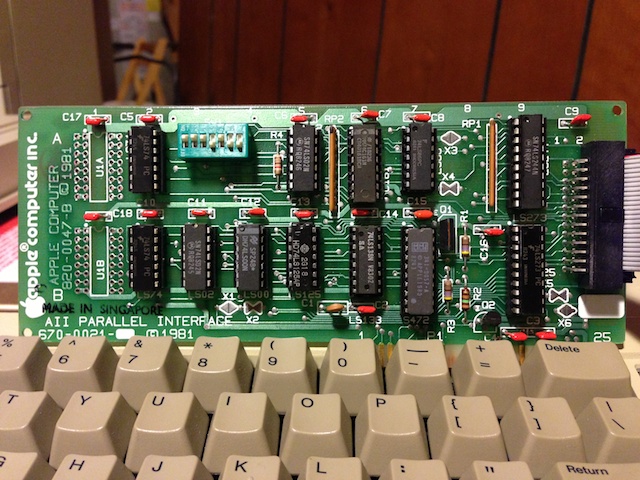
Someday finally came. I pulled out the programming specs on the QC and the APIC Installation and Operation Manual and went about figuring out the details of mapping the PC parallel port pinouts of the QC to the APIC. This is the cable magic required to connect them together:
APIC Signal/Pin QuickCam Signal/Pin
Strobe 15 PCAck 17
Ack 16 CamRDY 15
Input D7 18 Nybble3 11
Input D6 21 Nybble2 10
Input D5 19 Nybble1 12
Input D4 14 Nybble0 13
Input D3 25 Nybble3 11
Input D2 3 Nybble2 10
Input D1 17 Nybble1 12
Input D0 1 Nybble0 13
Output D7 13 Cmd7 9
Output D6 12 Cmd6 8
Output D5 11 Cmd5 7
Output D4 23 Cmd4 6
Output D3 22 Cmd3 5
Output D2 8 Cmd2 4
Output D1 6 Cmd1 3
Output D0 5 Cmd0 2
Aux Strobe 7 *Reset 16
GND 24,20,4,2 GND 18-25
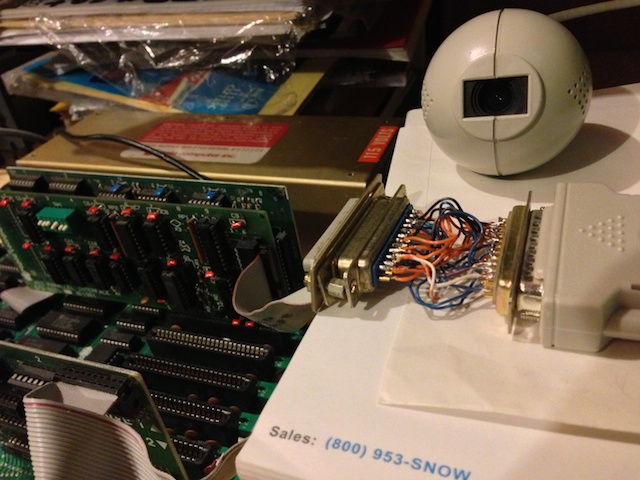
There are a few things to take note of. First, the output from the QC, Nybble3-0 is mapped to both to the most significant and the least significant nybble of the APICs 8 bit input port. Since there are only enough I/O pins to implement the 4 bit communications protocol, I decided to map the one QC nybble to a full byte of input to the APIC. The 6502 isn’t very good at shifting, so this alleviates the need to shift the nybble around for certain algorithms. The second thing to note is the output strobe of the APIC connected to the PCAck of the QC. This is one of the major handshake lines that works in conjunction with the CamRDY line for transferring data. The host needs to hold this line high until the QC signals data is ready by raising CamRDY. However, the APICs strobe is pulsed for a short duration, automatically returning to its previous state based upon switch settings on the APIC. The strobe duration can be set using the first three switches on the APIC, from 1 us to 15 us. Luckily, by maxing out the strobe duration to 15 us gives the 6502 just enough time to check the PCAck from the QC and re-triggering the strobe if it isn’t ready, or reading the data input port if it is – all before the strobe falls. The second nybble from the QC quickly follows the first, so there was no need to check the handshaking signals again if the 6502 did enough work in-between nybble reads. The last fortuitous connection was the Aux Strobe to *Reset. The Aux Strobe isn’t really documented in the APIC manual except for the block diagram. It delivers a short pulse whenever a certain address is accessed, and just happens to be active low, matching the requirements for the *Reset on the QC. The APIC allows for the selection of active high or low for the regular strobe signal, thus matching the QCs PCAck signal. The switch settings required on the APIC are thus:
APIC SWITCH BLOCK
1 2 3 4 5 6 7
ON ON ON OFF ON OFF OFF
As this is a fairly delicate connection that I didn’t want to have to re-solder, I wanted to get a DB-25 dual ended hood to create a professional, reliable dongle. However, those parts are no longer made, so I had to buy two DB-25 hoods and take a hack saw to them to create the piece I wanted. Ultimately, I ended up with this:
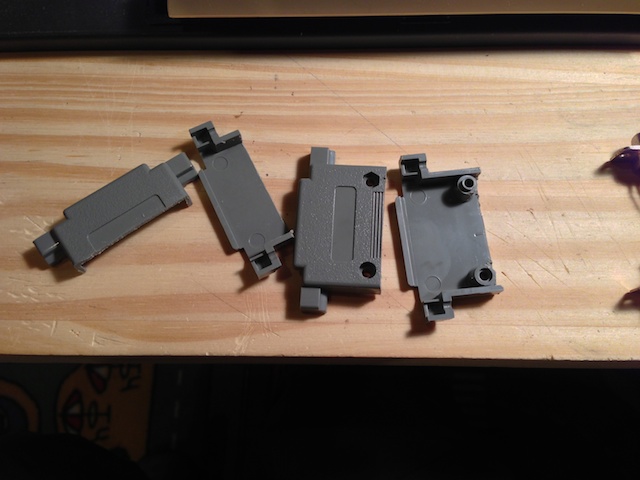
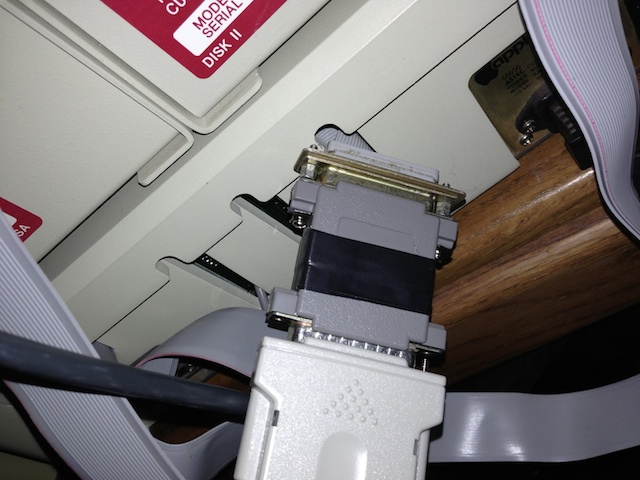
Finally, the QuickCam takes its power from the PS/2->AT keyboard connector since the parallel port doesn’t provide any. I went through the parts bin, found an old +5V power adapter, an old keyboard cable to hack up, and along with a trip to Radio Shack for the power plug, created this:
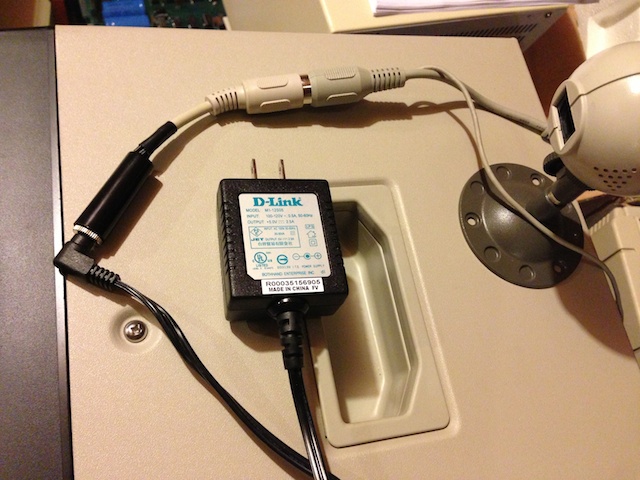 The only lines required to connect are the +5V and ground. Here is a link to a nice diagram showing which pins are power for the two connector types: http://www.bbdsoft.com/keyboard.html
The only lines required to connect are the +5V and ground. Here is a link to a nice diagram showing which pins are power for the two connector types: http://www.bbdsoft.com/keyboard.html
Continue on to Connectix QuickCam and the Apple II, Part II – The Software